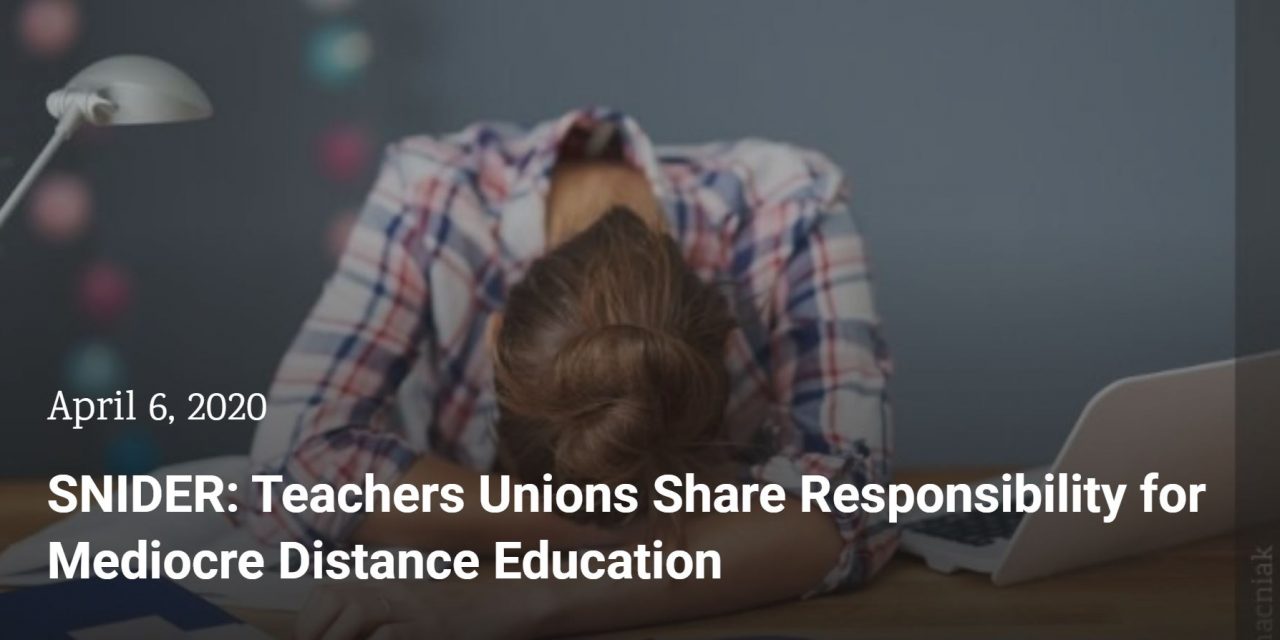What will be necessary to dramatically improve the mediocre distance education that many K-12 public schools are providing in response to the coronavirus? With almost all K-12 public school students now missing school and families increasingly frustrated by the distance education on offer, this has become a pressing problem and one that may continue into the next school year.
What’s causing the problem?
It may be politically incorrect and dangerous to say so, but a major contributing factor is the power and agenda of the educator unions, especially teachers’ unions.
Procedurally, the slow process of bargaining with teachers’ unions is ill-suited to address fast-emerging problems such as the coronavirus caused school closures. In many districts, the unions’ political power has secured them de facto veto power over distance education reforms they oppose, such as high-quality course-based choice.
Here in Anne Arundel County, the annual budget cycle is nearly over without substantial new funds allocated to distance education. Any attempt to shift substantial funds away from agreed-upon deals with the unions has been viewed as political suicide. In Maryland, the legislature adjourned after providing health and economic assistance in the wake of the coronavirus but doing nothing to provide suffering families with high-quality distance education options.
Substantively, the unions have opposed distance education options that would directly compete with their members, including a student taking an online course because an in-school teacher is incompetent. There are exceptions to this rule, such as for a pregnant student who cannot attend school. But even for the exceptions, the online instruction has tended to be low cost and thus low quality, which has freed up resources for expenditures that directly benefit union members. Imagine how the quality of classroom courses would plummet if teachers were paid like substitute teachers.
In Anne Arundel County during the fall semester, the average cost of an online course was approximately 1.5% of the total amount a student costs per year, only about 0.15% of students took an online course, and students were not allowed to take a course that might compete with a teacher. Maryland requires local school districts to choose among a list of low cost, mediocre courses. When my son wanted to take a reasonably priced but excellent online high school level course offered by the Johns Hopkins Center for Talented Youth, he was refused.
The unions are now tolerating the spread of distance education provided that no substantial resources are diverted from their members and they retain a veto over competitive threats. But in the past, such provisos have led to the current predicament of mediocre K-12 public school distance education, and in the current crisis will continue to hinder needed reforms.
Good distance education is not only about distance; it’s also about novel forms of scale, personalization, and specialization. Trying to replicate existing classroom practices at a distance is a recipe for mediocrity. It’s like restricting computers to old-fashioned board games because the board game guild won’t tolerate modern computer games. Doing distance education well requires a fundamental rethinking of how education resources should be deployed. But such an agenda runs headlong into union opposition, which is why post-coronavirus distant education leaders among public schools, such as Summit, Kipp, and Success Academy, tend to be charter schools.
K-12 educators’ slow, inadequate, and union circumscribed rollout of distant education options in response to coronavirus should be criticized, where appropriate. If school closures continue into next fall, the problem will get much worse unless distance education options are radically expanded.
Planning for fall closures should begin now and include online courses and virtual charter school options for families. When you hear educators and their allies blame everyone but themselves for the current distant education offerings, ask them to look in the mirror. Educators should not be allowed to place their interests above students’ in dealing with the coronavirus.
#
J.H. Snider often writes about education policy & politics and has contributed chapters to two widely used textbooks on computers in education.
Source: Snider, J.H., Teachers’ unions share responsibility for mediocre distance education, The Capital, April 5, 2020. For a visual image of the article, see Teachers’ unions share responsibility for mediocre distance education.
Some related research:
- For some of the local research that went into this article, see AACPS’s PR Operation & Censorship by PIO. In addition, I reached out to parents and school board members.
- Two recent Wall Street Journal editorials had a similar political analysis: Oregon’s Coronavirus Education Lockdown: Teachers unions block kids from transferring to virtual charter schools and Berkeley Schools Leave Every Child Behind. Postscript: Here’s a third one from the WSJ: The Teachers Union Ate My Homework.
- Over the years I have published many articles on K-12 course-based choice. The Hechinger Report published two recent ones: one on the dismal politics of course-based choice; the other on some practical obstacles to course-based choice. Many years ago Education Week published one on its back cover: Should School Choice Come Via the Internet? And near the dawn of the Internet age USA Today published one, Education Technology Clashes with Teachers, along with a dueling commentary by the then president of the National Education Association, Keith Geiger. The USA Today article was an excerpt from my article published in The Futurist: Education wars: The battle over Information-Age technology, Vol. 30, Iss. 3, (May/June 1996): 24-28.
Some other resources I like:
- UNESCO’s Global Education Coalition, including its list of education resources.
- Education Cannot Wait
- Choice Media, an online hub for education news (this op-ed was also featured on its front page on April 6, 2020)

